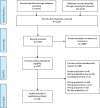Summarizing the effects of different exercise types in chronic low back pain - a systematic review of systematic reviews
- PMID: 35996124
- PMCID: PMC9394044
- DOI: 10.1186/s12891-022-05722-x
Summarizing the effects of different exercise types in chronic low back pain - a systematic review of systematic reviews
Abstract
Background: In chronic LBP (CLBP), guideline-endorsed treatment is to stay active, return to normal activity, and to exercise. Several reviews on various exercise types used in CLBP have been published. We aimed to identify systematic reviews of common exercise types used in CLBP, to appraise their quality, and to summarize and compare their effect on pain and disability.
Methods: We searched the databases OVID MEDLINE, EMBASE, COCHRANE LIBRARY, and WEB OF SCIENCE (Core collection) for systematic reviews and meta-analyses on adults between 18 and 70 years of age suffering from chronic or recurrent LBP for a period of at least 12 weeks, which investigated the effects of exercises on pain and disability. All searches were conducted without language restriction. The search was performed up until 2022-01-26. The included reviews were grouped into nine exercise types: aerobic training, aquatic exercises, motor control exercises (MCE), resistance training, Pilates, sling exercises, traditional Chinese exercises (TCE), walking, and yoga. The study quality was assessed with AMSTAR-2. For each exercise type, a narrative analysis was performed, and the level of evidence for the effects of exercise was assessed through GRADE.
Results: Our database search resulted in 3,475 systematic reviews. Out of the 253 full texts that were screened, we included 45 systematic reviews and meta-analyses. The quality of the included reviews ranged from high to critically low. Due to large heterogeneity, no meta-analyses were performed. We found low-to-moderate evidence of mainly short-term and small beneficial effects on pain and disability for MCE, Pilates, resistance training, TCE, and yoga compared to no or minimal intervention.
Conclusions: Our findings show that the effect of various exercise types used in CLBP on pain and disability varies with no major difference between exercise types. Many of the included systematic reviews were of low-to-moderate quality and based on randomized controlled trials with high risk of bias. The conflicting results seen, undermine the certainty of the results leading to very-low-to-moderate quality of evidence for our results. Future systematic reviews should be of higher quality to minimize waste of resources.
Trial registration: PROSPERO: Reg no 190409 Registration date 01AUG 2020.
Keywords: Physical activity; Physiotherapy; Rehabilitation; Spinal pain; Training.
© 2022. The Author(s).
Conflict of interest statement
The authors declare that they have no competing interests.
Figures
References
-
- Collaborators GDaIIaP. Global, regional, and national incidence, prevalence, and years lived with disability for 310 diseases and injuries, 1990–2015: a systematic analysis for the Global Burden of Disease Study 2015. Lancet. 2016;388(10053):1545–602. doi: 10.1016/S0140-6736(16)31678-6. - DOI - PMC - PubMed
Publication types
MeSH terms
LinkOut - more resources
Full Text Sources
Medical
Research Materials
Miscellaneous


